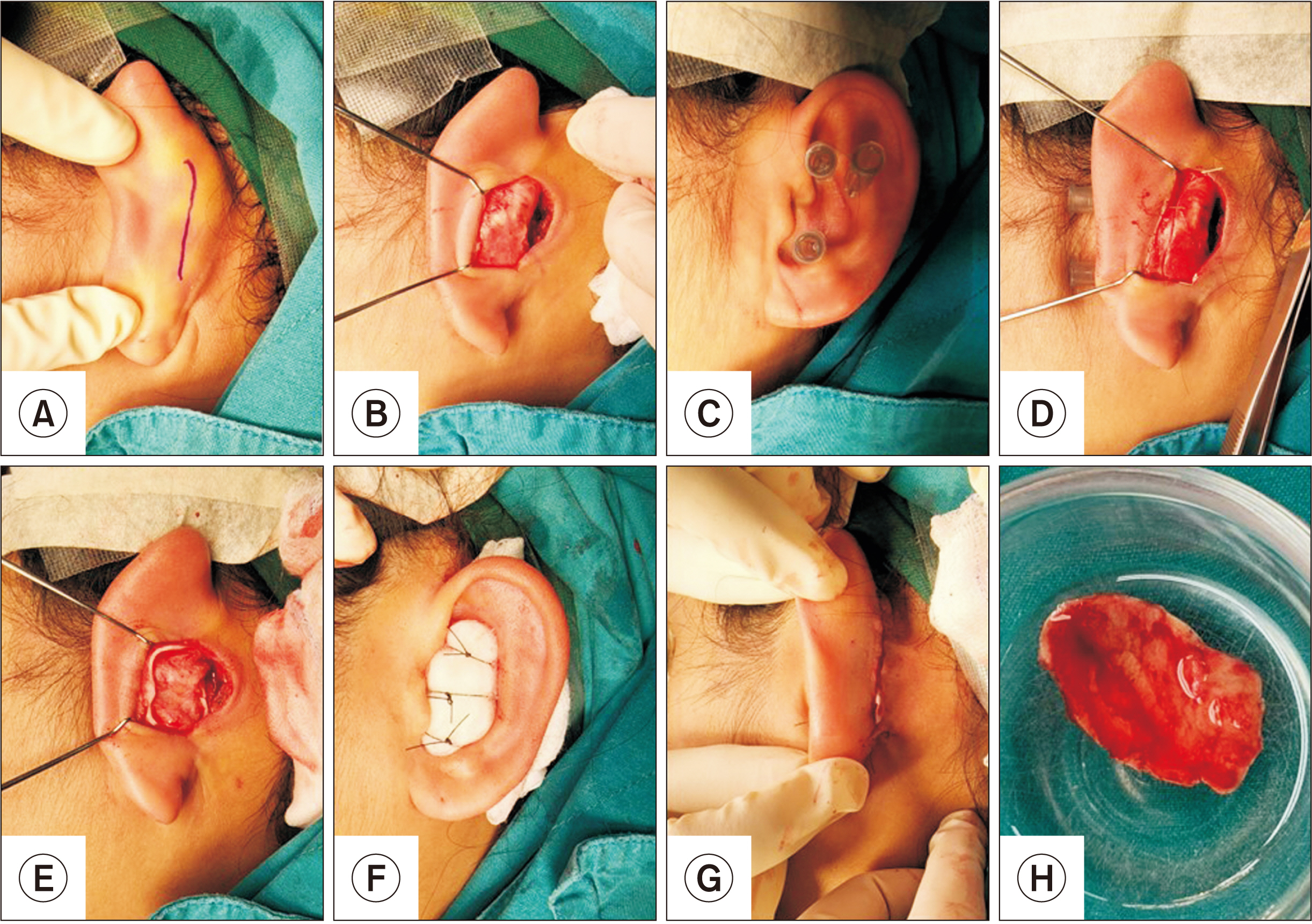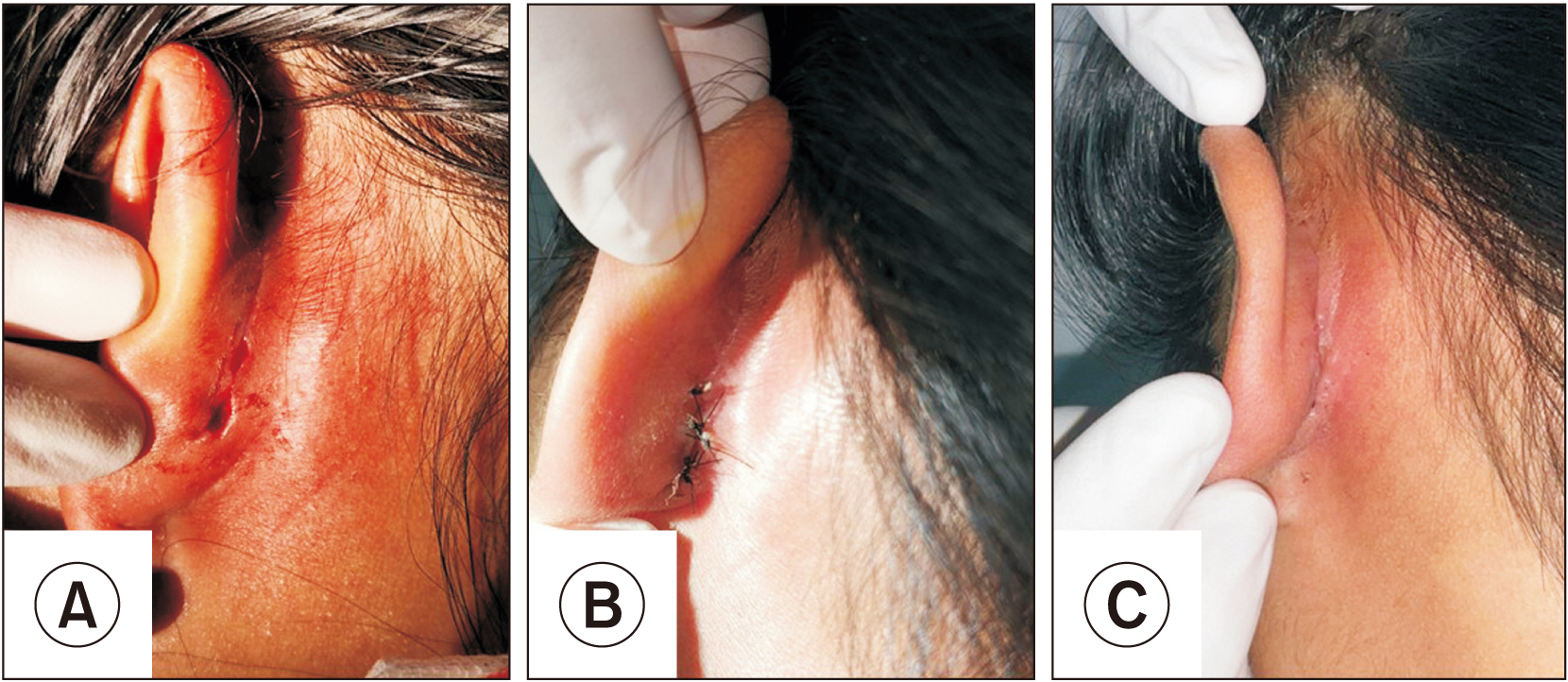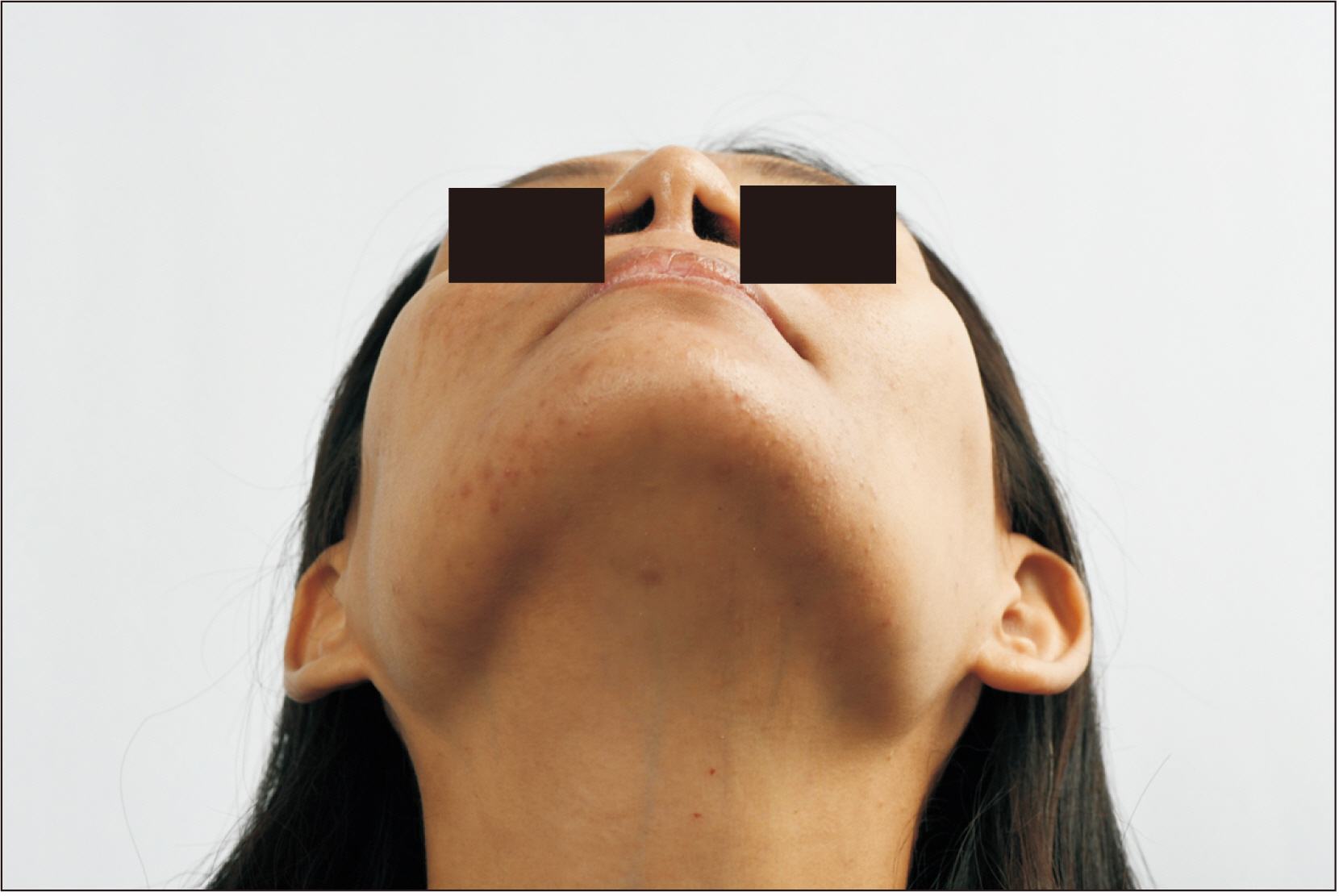J Korean Assoc Oral Maxillofac Surg.
2023 Oct;49(5):270-277. 10.5125/jkaoms.2023.49.5.270.
Donor site morbidities of concha cartilage harvesting using a retroauricular approach for cleft rhinoplasty: retrospective study
- Affiliations
-
- 1Department of Oral and Maxillofacial Surgery, Faculty of Dentistry, Mahidol University, Bangkok, Thailand
- KMID: 2547571
- DOI: http://doi.org/10.5125/jkaoms.2023.49.5.270
Abstract
Objectives
Concha cartilage is recommended for correction of cleft nasal deformities. Morbidities at the donor site have been reported in esthetic rhinoplasty cases. Reports on cleft patients are limited, so we investigated the complications of concha cartilage harvesting using the retroauricular approach in cleft rhinoplasty and their management.
Materials and Methods
This was a retrospective review of the charts of 63 patients with cleft deformities who underwent septorhinoplasty with concha cartilage. All cases were harvested using a retroauricular approach. Data on patient demographics, surgery type, amount of cartilage harvested, and complications were gathered.
Results
Sixty-three patients were enrolled (21 males and 42 females). The mean age of patients was 20.2±5.9 years. Complications were observed in 6 cases (9.5%) and included delayed wound healing (4.8%), prolonged postoperative pain (1.6%), postoperative paresthesia (1.6%), and prominauris (1.6%).
Conclusion
The rate of complications associated with concha cartilage harvesting using a retroauricular approach is low. The use of meticulous surgical techniques, especially hemostasis control and adequate wound dressing, is key to minimizing postoperative complications.
Keyword
Figure
Reference
-
References
1. Lim JS, Lee GT, Jung YS. 2012; Repair of bilateral cleft lip and nose by the Mulliken method: a case report. J Korean Assoc Oral Maxillofac Surg. 38:360–5. http://doi.org/10.5125/jkaoms.2012.38.6.360. DOI: 10.5125/jkaoms.2012.38.6.360.
Article2. Hsieh TY, Dedhia R, Del Toro D, Tollefson TT. 2017; Cleft septorhinoplasty: form and function. Facial Plast Surg Clin North Am. 25:223–38. https://doi.org/10.1016/j.fsc.2016.12.011. DOI: 10.1016/j.fsc.2016.12.011. PMID: 28340653.
Article3. Wong CH, Daniel RK, Lee ST. 2017; Asian cleft rhinoplasty: the open structural approach. Aesthet Surg J. 38:28–37. https://doi.org/10.1093/asj/sjx197. DOI: 10.1093/asj/sjx197. PMID: 29149246.
Article4. Cuzalina A, Tolomeo PG. 2021; Challenging rhinoplasty for the cleft lip and palate patient. Oral Maxillofac Surg Clin North Am. 33:143–59. https://doi.org/10.1016/j.coms.2020.09.012. DOI: 10.1016/j.coms.2020.09.012. PMID: 33246546.
Article5. Rohrich RJ, Benkler M, Avashia YJ, Savetsky IL. 2021; Secondary rhinoplasty for unilateral cleft nasal deformity. Plast Reconstr Surg. 148:133–43. https://doi.org/10.1097/prs.0000000000008124. DOI: 10.1097/PRS.0000000000008124. PMID: 34076624.
Article6. Hoang TA, Lee KC, Dung V, Chuang SK. 2022; Augmentation rhinoplasty in cleft lip nasal deformity using alloplastic material and autologous cartilage. J Craniofac Surg. 33:e883–6. https://doi.org/10.1097/scs.0000000000008848. DOI: 10.1097/SCS.0000000000008848. PMID: 35920855.
Article7. Ham J, Miller PJ. 2003; Expanded polytetrafluoroethylene implants in rhinoplasty: literature review, operative techniques, and outcome. Facial Plast Surg. 19:331–9. https://doi.org/10.1055/s-2004-815653. DOI: 10.1055/s-2004-815653. PMID: 14737702.
Article8. Keyhan SO, Ramezanzade S, Yazdi RG, Valipour MA, Fallahi HR, Shakiba M, et al. 2022; Prevalence of complications associated with polymer-based alloplastic materials in nasal dorsal augmentation: a systematic review and meta-analysis. Maxillofac Plast Reconstr Surg. 44:17. https://doi.org/10.1186/s40902-022-00344-8. DOI: 10.1186/s40902-022-00344-8. PMID: 35451637. PMCID: PMC9033909.
Article9. Mowlavi A, Pham S, Wilhelmi B, Masouem S, Guyuron B. 2010; Anatomical characteristics of the conchal cartilage with suggested clinical applications in rhinoplasty surgery. Aesthet Surg J. 30:522–6. https://doi.org/10.1177/1090820x10380862. DOI: 10.1177/1090820X10380862. PMID: 20829249.
Article10. Han Z, Wu B, Jiang B, Song P, Li G, Xu J. 2022; Effect of dichotomous conchal cartilage transplantation on correction of unilateral cleft lip nasal deformity. J Craniofac Surg. 33:592–6. https://doi.org/10.1097/scs.0000000000008060. DOI: 10.1097/SCS.0000000000008060. PMID: 34334746.
Article11. Lee M, Callahan S, Cochran CS. 2011; Auricular cartilage: harvest technique and versatility in rhinoplasty. Am J Otolaryngol. 32:547–52. https://doi.org/10.1016/j.amjoto.2010.11.008. DOI: 10.1016/j.amjoto.2010.11.008. PMID: 21316123.
Article12. Nolst Trenité GJ, Paping RH, Trenning AH. 1997; Rhinoplasty in the cleft lip patient. Cleft Palate Craniofac J. 34:63–8. https://doi.org/10.1597/1545-1569_1997_034_0063_ritclp_2.3.co_2. DOI: 10.1597/1545-1569_1997_034_0063_ritclp_2.3.co_2. PMID: 9003914.
Article13. Boccieri A, Marano A. 2007; The conchal cartilage graft in nasal reconstruction. J Plast Reconstr Aesthet Surg. 60:188–94. https://doi.org/10.1016/j.bjps.2006.02.005. DOI: 10.1016/j.bjps.2006.02.005. PMID: 17223517.
Article14. Wee JH, Park MH, Oh S, Jin HR. 2015; Complications associated with autologous rib cartilage use in rhinoplasty: a meta-analysis. JAMA Facial Plast Surg. 17:49–55. https://doi.org/10.1001/jamafacial.2014.914. DOI: 10.1001/jamafacial.2014.914. PMID: 25429595.
Article15. Kozlov MI. 1998; [Chondroperichondritis of costal cartilages as a complication of surgical approaches to the thorax without direct injury of the cartilage]. Vestn Khir Im I I Grek. 157:48–50. Russian. PMID: 9691381.16. Nanda V, Sharma RK, Tuli P, Makkar S. 2005; Costal cartilage necrosis--an unusual complication of electric injury. Burns. 31:665–7. https://doi.org/10.1016/j.burns.2005.01.007. DOI: 10.1016/j.burns.2005.01.007. PMID: 15955635.
Article17. Rhomberg W, Schuster A. 2014; Premature calcifications of costal cartilages: a new perspective. Radiol Res Pract. 2014:523405. https://doi.org/10.1155/2014/523405. DOI: 10.1155/2014/523405. PMID: 25587444. PMCID: PMC4284933.
Article18. Lu TC, Yao CF, Lin S, Chang CS, Chen PK. 2017; Primary septal cartilage graft for the unilateral cleft rhinoplasty. Plast Reconstr Surg. 139:1177–86. https://doi.org/10.1097/prs.0000000000003297. DOI: 10.1097/PRS.0000000000003297. PMID: 28098711.
Article19. Zhang L, Bai X, Li Z, Liu Q, Yang M, Wang X, et al. 2018; Improvement of aesthetic and nasal airway in patients with cleft lip nasal deformities: rhinoplasty with septal cartilage graft and septoplasty. Cleft Palate Craniofac J. 55:554–61. https://doi.org/10.1177/1055665617746260. DOI: 10.1177/1055665617746260. PMID: 29554442.
Article20. Lee JS, Lee DC, Ha DH, Kim SW, Cho DW. 2016; Redefining the septal L-strut to prevent collapse. PLoS One. 11:e0153056. https://doi.org/10.1371/journal.pone.0153056. DOI: 10.1371/journal.pone.0153056. PMID: 27073993. PMCID: PMC4830535.
Article21. Hantawornchaikit T, Arayasantiparb R, Kumar K, Boonsiriseth K. 2022; Three-dimensional analysis of definitive secondary unilateral cleft rhinoplasty using cartilage graft. Cleft Palate Craniofac J. 59:1072–8. https://doi.org/10.1177/10556656211034099. DOI: 10.1177/10556656211034099. PMID: 34402317.
Article22. Wright ST, Calhoun KH, Decherd M, Quinn FB. 2007; Conchal cartilage harvest: donor site morbidities, patient satisfaction, and cosmetic outcomes. Arch Facial Plast Surg. 9:298–9. https://doi.org/10.1001/archfaci.9.4.298. DOI: 10.1001/archfaci.9.4.298. PMID: 17638769.
Article23. Kim JY, Yang HJ, Jeong JW. 2017; A new technique for conchal cartilage harvest. Arch Plast Surg. 44:166–9. https://doi.org/10.5999/aps.2017.44.2.166. DOI: 10.5999/aps.2017.44.2.166. PMID: 28352607. PMCID: PMC5366525.
Article24. Jovanovic S, Berghaus A. 1991; Autogenous auricular concha cartilage transplant in corrective rhinoplasty. Practical hints and critical remarks. Rhinology. 29:273–9. PMID: 1780628.25. Nemoto T, Matsui Y, Shirota T, Irie T, Tachikawa T. 2008; Two cases of scar formation in donor site for conchal cartilage grafting. J Jpn Stomatol Soc. 57:278–82. https://doi.org/10.11277/stomatology1952.57.278.
Article26. Du H, Zhang D, Zong X, Song G, Zhao J, Yang C, et al. 2021; A simple dressing fixation method following harvest of the ear cartilage graft. J Craniofac Surg. 32:e240–2. https://doi.org/10.1097/scs.0000000000006965. DOI: 10.1097/SCS.0000000000006965. PMID: 32890175.
Article27. Muenker R. 1984; The bilateral conchal cartilage graft: a new technique in augmentation rhinoplasty. Aesthetic Plast Surg. 8:37–42. https://doi.org/10.1007/bf01572783. DOI: 10.1007/BF01572783. PMID: 6731159.
Article28. Mudry A, Pirsig W. 2009; Auricular hematoma and cauliflower deformation of the ear: from art to medicine. Otol Neurotol. 30:116–20. https://doi.org/10.1097/mao.0b013e318188e905. DOI: 10.1097/MAO.0b013e318188e905. PMID: 18800018.
Article29. Mohan V, Bhavani S, Subramanian SK, Maiti A. 2017; Calcified cauliflower ear in relapsing polychondritis. BMJ Case Rep. 2017:bcr2017219424. https://doi.org/10.1136/bcr-2017-219424. DOI: 10.1136/bcr-2017-219424. PMID: 28432170. PMCID: PMC5534701.
Article30. Zilinsky I, Erdmann D, Weissman O, Hammer N, Sora MC, Schenck TL, et al. 2017; Reevaluation of the arterial blood supply of the auricle. J Anat. 230:315–24. https://doi.org/10.1111/joa.12550. DOI: 10.1111/joa.12550. PMID: 27726131. PMCID: PMC5244454.
Article31. Lan MY, Park JP, Jang YJ. 2017; Donor site morbidities resulting from conchal cartilage harvesting in rhinoplasty. J Laryngol Otol. 131:529–33. https://doi.org/10.1017/s0022215117000639. DOI: 10.1017/S0022215117000639. PMID: 28316288.
Article32. Ro HS, Roh SG, Shin JY, Lee NH, Yang KM. 2017; Iatrogenic through-and-through conchal defect secondary to auricular cartilage graft. Aesthetic Plast Surg. 41:56–9. https://doi.org/10.1007/s00266-016-0764-0. DOI: 10.1007/s00266-016-0764-0. PMID: 28032171.
Article33. Kim SW, Park CW, Kim JT, Kim YH. 2012; Merocel semicompressive dressing to prevent donor-site hematoma on the conchal cartilage graft. J Craniofac Surg. 23:57–60. https://doi.org/10.1097/scs.0b013e318240c908. DOI: 10.1097/SCS.0b013e318240c908. PMID: 22337374.
Article34. Grobbelaar AO, Matti BA, Nicolle FV. 1997; Donor site morbidity post-conchal cartilage grafting. Aesthetic Plast Surg. 21:90–2. https://doi.org/10.1007/s002669900090. DOI: 10.1007/s002669900090. PMID: 9143422.
Article35. Elazhary EA, Abd Al-Salam FM, Abd El-Hafiz HS, Maghraby HK. 2022; Updates on keloid scar pathogenesis, assessment and treatment modalities. J Recent Adv Med. 3:75–86. DOI: 10.21608/jram.2021.82892.1123.
Article36. Butt MF, Albusoda A, Farmer AD, Aziz Q. 2020; The anatomical basis for transcutaneous auricular vagus nerve stimulation. J Anat. 236:588–611. https://doi.org/10.1111/joa.13122. DOI: 10.1111/joa.13122. PMID: 31742681. PMCID: PMC7083568.
Article37. Deleyiannis FW. 2010; Reconstruction of the concha to restore hearing after cartilage harvest for rhinoplasty. Arch Otolaryngol Head Neck Surg. 136:304–5. https://doi.org/10.1001/archoto.2010.23. DOI: 10.1001/archoto.2010.23. PMID: 20231653.
Article38. Adams WM. 1955; Construction of upper half of auricle utilizing composite concha cartilage graft with perichondrium attached on both sides. Plast Reconstr Surg (1946). 16:88–96. https://doi.org/10.1097/00006534-195508000-00002. DOI: 10.1097/00006534-195508000-00002. PMID: 13254361.
Article39. Han K, Kim J, Son D, Park B. 2008; How to harvest the maximal amount of conchal cartilage grafts. J Plast Reconstr Aesthet Surg. 61:1465–71. https://doi.org/10.1016/j.bjps.2007.09.038. DOI: 10.1016/j.bjps.2007.09.038. PMID: 17996506.
Article
- Full Text Links
- Actions
-
Cited
- CITED
-
- Close
- Share
- Similar articles
-
- Two Cases of Tragal Cartilage Graft in Rhinoplasty
- Surgical importance of the posterior auricular ligament when harvesting ear cartilage in rhinoplasty
- The Usefulness of Allogenous Costal Cartilage Graft for Correction of Short Nose and Tip Plasty
- 10th Rib Cartilage: Another Option of the Costal Cartilage Graft for Rhinoplasty
- Corrective Rhinoplasty with Combined Use of Autogenous Auricular Cartilage and Porcine Dermal Collagen in Cleft Lip Nose Deformity




